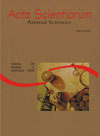<b>Efeito dos níveis de energia e programas de alimentação sobre a qualidade de carcaça e desempenho de frangos de corte abatidos tardiamente</b> - DOI: 10.4025/actascianimsci.v29i1.250
Resumo
O experimento foi realizado com o objetivo de avaliar diferentes níveis de energia e programas de alimentação sobre a qualidade de carcaça e carne de frangos de corte entre 42 e 57 dias de idade. Foram utilizados 1.600 pintos machos “Cobb”, em um delineamento inteiramente ao acaso, em esquema fatorial 2x4, sendo dois níveis de energia (3.200 e 3.600 kcal EM kg-1) e quatro programas de alimentação (recomendações de aminoácidos). Foram avaliados as características de carcaça (rendimento de carcaça, de peito e de coxas + sobrecoxas) e carne (cor, pH, perdas por cocção, força de cisalhamento, capacidade de retenção de água e análise sensorial) e os dados de desempenho (ganho de peso, consumo de ração, conversão alimentar e conversão calórica). Os níveis energéticos ou os diferentes programas de alimentação não determinaram diferenças expressivas na qualidade da carcaça ou de carne que justifiquem a escolha de um nível de energia ou de um programa alimentar, devendo prevalecer o nível energético e as recomendações de aminoácidos que determinem o maior custo-benefício. Observou-se que o nível de 3.600 kcal EM kg-1 proporcionou melhoria no desempenho das aves, enquanto que o fracionamento das exigências de aminoácidos digestíveis em dois períodos determinou piores resultados.Downloads
DECLARAÇÃO DE ORIGINALIDADE E DIREITOS AUTORAIS
Declaro que o presente artigo é original, não tendo sido submetido à publicação em qualquer outro periódico nacional ou internacional, quer seja em parte ou em sua totalidade.
Os direitos autorais pertencem exclusivamente aos autores. Os direitos de licenciamento utilizados pelo periódico é a licença Creative Commons Attribution 4.0 (CC BY 4.0): são permitidos o compartilhamento (cópia e distribuição do material em qualqer meio ou formato) e adaptação (remix, transformação e criação de material a partir do conteúdo assim licenciado para quaisquer fins, inclusive comerciais.
Recomenda-se a leitura desse link para maiores informações sobre o tema: fornecimento de créditos e referências de forma correta, entre outros detalhes cruciais para uso adequado do material licenciado.








































